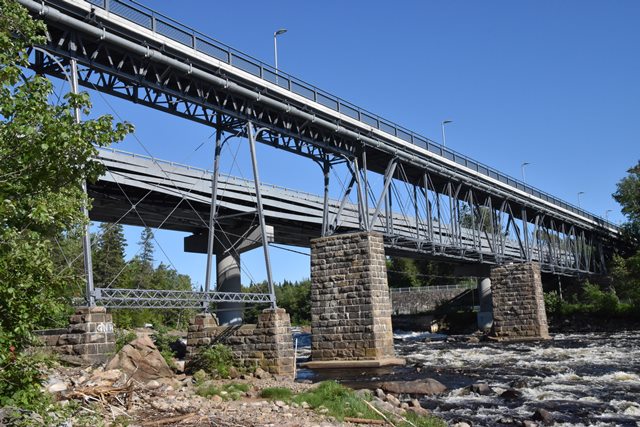We Recommend:
Bach Steel - Experts at historic truss bridge restoration.
BridgeHunter.com Phase 1 is released to the public! - Visit Now
Pont de Shannon (Shannon Bridge)
Pont Gosford (Gosford Bridge)

Primary Photographer(s): Nathan Holth
Bridge Documented: July 8, 2019
Shannon: Capitale-Nationale, Québec: Canada
Metal 7 Panel Pin-Connected Pratt Deck Truss, Fixed and Approach Spans: Metal 8 Panel Rivet-Connected Warren Deck Truss, Fixed
1880 By Builder/Contractor: Clarke, Reeves and Company of Philadelphia, Pennsylvania (Phoenix Bridge Company of Phoenixville, Pennsylvania)
Not Available or Not Applicable
126.5 Feet (38.6 Meters)
509.8 Feet (155.4 Meters)
Not Available
2 Main Span(s) and 6 Approach Span(s)
Not Applicable

View Information About HSR Ratings
Bridge Documentation
Preserved for pedestrian use, this ancient iron bridge is one of the only known truss bridges in Canada with the rare Phoenix columns. The bridge was originally built as a railway bridge but eventually abandoned by the railway and ownership of the bridge passed to the municipality in 1929 who converted it for vehicular use in 1931-1932. It served vehicular traffic until 2015 when a new highway bridge was built next to the heritage bridge. At this time, the heritage bridge was restored and preserved for pedestrian use. This bridge is one of the most important heritage bridges in Canada due to its age, use of Phoenix columns, and outstanding historic integrity. The only major alteration is replacement of some of the sway bracing Phoenix columns with welded replacements. However, the truss lines remain unaltered, and even the deck stringers remain original with Phoenix Iron still clearly visible on the beams. The bridge is composed of two large approximately 126 foot pin-connected Pratt deck truss spans which make use of Phoenix columns in their members and chords. There are also shorter approximately 43 foot rivet-connected Warren deck truss approach spans. These spans are also a design used by the Phoenix Bridge Company and they are among some of the oldest rivet-connected truss spans in Canada, since pin connections were more common at this time. The approach spans are supported by bents that also use Phoenix columns.
The Phoenix-designed deck truss approach spans seen on this bridge can also be seen on the Phoenix Bridge in Virginia.
View Detailed Heritage Report For This Bridge
View Text Only English Translation of Detailed Heritage Report For This Bridge
Above: Historical image of bridge.
Above: Historical image of bridge.
Information and Findings From Répertoire du patrimoineDiscussion of Bridge Le pont de Shannon a été inauguré le 1er décembre 1880 dans le but d'enjamber la rivière Jacques-Cartier sur la ligne de chemin de fer Québec-Gosford. À la fin des années 1910, les Chemins de fer Nationaux du Canada jugent que les nouvelles locomotives sont trop lourdes pour emprunter le pont de la Phoenix Bridge. On construit un nouveau pont (aujourd'hui utilisé comme piste cyclable) à un peu plus d'un km. En 1920, une voie pour les automobiles y est aménagée. En 1929, le Canadien National cède le pont à la municipalité. Il ne sera donc plus utilisé pour aucun type de train. La valeur patrimoniale accordée à cet ouvrage de génie civil repose principalement sur son intérêt historique, son authenticité, son architecture et sa valeur de position. Bien qu'il serve toujours à enjamber la rivière Jacques-Cartier, son usage a été quelque peu transformé puisqu'il n'est plus utilisé pour le passage des trains. Il constitue également un des derniers spécimens de structure en acier de type Phoenix au Québec. Le ministère des Transports considère ce pont comme ayant une grande valeur patrimoniale. English Translation The Shannon Bridge was inaugurated on December 1, 1880 in order to cross the Jacques-Cartier River on the Quebec-Gosford railway line. In the late 1910s, the Canadian National Railways determined that the new locomotives were too heavy to use the Phoenix Bridge. They built a new bridge (now used as a bike path) just over a km away. In 1920, a railway bridge was built there. In 1929, the Canadian National ceded the bridge to the municipality. It will therefore no longer be used for any type of train. The heritage value accorded to this civil engineering work rests mainly on its historical interest, its authenticity, its architecture and its position value. Although it is still used to span the Jacques-Cartier River, its use has been somewhat transformed since it is no longer used for the passage of trains. It is also one of the last specimens of Phoenix-type steel structure in Quebec. The Ministère des Transports considers this bridge to be of great heritage value. Bridge Considered Historic By Survey: Yes |
![]()
Photo Galleries and Videos: Pont de Shannon (Shannon Bridge)
Bridge Photo-Documentation
Original / Full Size PhotosA collection of overview and detail photos. This gallery offers photos in the highest available resolution and file size in a touch-friendly popup viewer.
Alternatively, Browse Without Using Viewer
![]()
Bridge Photo-Documentation
Mobile Optimized PhotosA collection of overview and detail photos. This gallery features data-friendly, fast-loading photos in a touch-friendly popup viewer.
Alternatively, Browse Without Using Viewer
![]()
Maps and Links: Pont de Shannon (Shannon Bridge)
Coordinates (Latitude, Longitude):
Search For Additional Bridge Listings:
Additional Maps:
Google Streetview (If Available)
GeoHack (Additional Links and Coordinates)
Apple Maps (Via DuckDuckGo Search)
Apple Maps (Apple devices only)
Android: Open Location In Your Map or GPS App
Flickr Gallery (Find Nearby Photos)
Wikimedia Commons (Find Nearby Photos)
Directions Via Sygic For Android
Directions Via Sygic For iOS and Android Dolphin Browser



